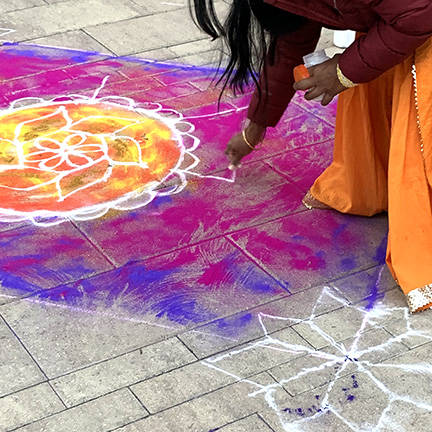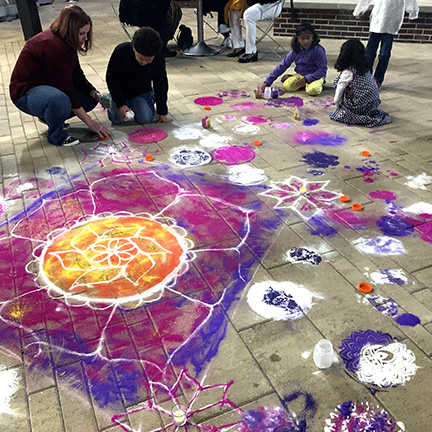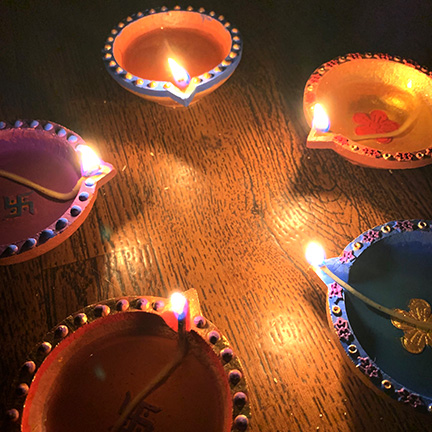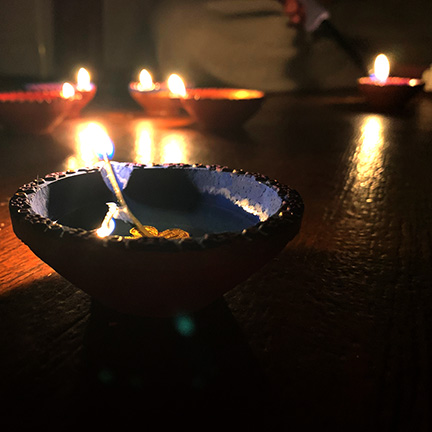The Gamecock Bhangra team performed at the Diwali Kickoff Party in Boyd Plaza at the Columbia Museum of Art. (Photos by Kaylie Pomichalek)
Arunima Sinhaa remembers feeling lonely after moving from India to New York state with her husband.
She moved just before the Hindi celebration of Diwali. Normally, she would have been celebrating with her family in India. She would have been cleaning and decorating. She would have been eating sweets and exchanging gifts. She would be setting off fireworks.
But in New York, “I had just one lamp in my house.”
The single lamp couldn’t compare to the thousands that would have filled houses and streets back home.
Diwali is Hindu’s Festival of Lights, which is typically five days long and starts in late October or early November — the end of the Hindu calendar. The festival is now celebrated by most Indians, having transcended its religious roots.
The White House celebrated Diwali for the first time in 2003. Four years later, Congress officially recognized it. And starting next year, Diwali will be a public school holiday in New York City.
“Think about it — how close it is to Christmas and the holiday season and Thanksgiving,” she said. “It’s all about sharing. Its all about light. Its all about love. Its all about joy. And … (everyone is) slowly realizing it.”
While the holiday may be gaining traction in large cities such as New York, it still can feel lonely for the more than 7,000 Asian Indians celebrating in Richland and Lexington counties.
“Sometimes it’s hard to celebrate five days,” said Jugnu Verma, an Indian folk artist who learned her skills from her family in India. “If Diwali is on a weekday, … my husband is working and my daughter goes to school. So we don’t have exactly the whole time to celebrate. But still I’m trying.”
Diwali is thousands of years old. Its origin is uncertain. Some say it commemorates the day the god Lord Rama returned from exile with his wife and brother. Others believe it marks the day the god Lord Krishna defeated the demon Narakasura. For many others, it’s just a big party.
In India, schools are typically closed and businesses either shut down or close early.
That isn’t the case here.
Viren Patel, the owner of Indian Grocery in St. Andrews, said he and his family work on Diwali day. He has been here so long now that it’s normal for him.
But he still misses celebrating in India, especially with fireworks. More fireworks go off in India during Diwali than go off here on July 4 or New Years Eve, he said.
There are so many fireworks, in fact, that some places in India have banned them or shortened the window in which they can be fired — not because they are loud, but because they add to already bad air pollution, according to multiple Indian news outlets.
Patel is also careful with fireworks, but not because of air pollution.
“We have to think about the neighbors,” he said. “We are doing a limited version of Diwali,” so we don’t disturb anyone.
Sinhaa, who moved from New York, now works with the Hindu Temple and Cultural Center in Columbia. She said celebrating Diwali here still feels lonely. But making friends has helped, as has social media, where she can catch glimpses of the big celebrations in India.
She said she always takes her neighbors sweets during Diwali.
Verma has taken it a step further. She worked with the Columbia Museum of Art to host a Diwali Kickoff Party.
There was rangoli art, which is traditionally created on the floor of the entrance to a house to welcome good fortune. Verma said people often use what is in their pantries to create colorful patterns — powders, seeds, lentils and flowers are just some possible materials.
There were diya pots, used to decorate and light homes. Diyas, which are made of clay, are filled with oil and lit using a cotton wick. The pots represent the body and the cotton wick is the soul, Verma said. The oil in the pot represents troubles and negativity. By burning the oil, people burn away their troubles.
There was Bhangra, a traditional dance common at many Indian festivals.
Finally, there was teen patti, a gambling card game. Winning the game during Diwali ensures wealth in the coming year, Verma said.
In addition to the festival at the museum, Sinhaa’s Hindu temple also had a Diwali celebration.
But instead of five days, the temple had only one. About 700 people visited that day, Sinhaa said.
“It is different but not too different,” she said. “Everything can be modified. … Here we have to reduce it.”
In addition to the festivities, the temple held its usual worship service. Normally, multiple deities are worshiped and different days are dedicated to different deities.
During Diwali, though, most worship the goddess Lakshmi.
“Lakshmi is the goddess of wealth, and that is the goddess of Diwali,” Sinhaa said.
The goddess brings wealth and prosperity and happiness, she said, and can be worshiped in goddess form or in the form of money.
Wealth is a major Diwali theme, and religious beliefs are not required to celebrate.
Sinhaa said her children have lived in Columbia their entire lives, so the festivities here are all they know of the holiday.
“For them, Diwali is this …, ” she said. “This is Diwali, this is their temple, this is their community.”
After the performance, Gamecock Bhangra gave the audience a bhangra dance tutorial.
Party-goers continued to dance for the rest of the celebration.
It is common to buy new clothes during Diwali, as demonstrated by this mother and daughter wearing traditional Indian dresses.
These three women, wearing traditional dresses, are dancing as another takes a video.













